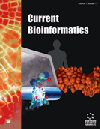- Home
- A-Z Publications
- Current Bioinformatics
- Previous Issues
- Volume 19, Issue 4, 2024
Current Bioinformatics - Volume 19, Issue 4, 2024
Volume 19, Issue 4, 2024
-
-
Bioinformatics Perspective of Drug Repurposing
More LessAuthors: Binita Patel, Brijesh Gelat, Mehul Soni, Pooja Rathaur and Kaid J. SRDifferent diseases can be treated with various therapeutic agents. Drug discovery aims to find potential molecules for existing and emerging diseases. However, factors, such as increasing development cost, generic competition due to the patent expiry of several drugs, increase in conservative regulatory policies, and insufficient breakthrough innovations impairs the development of new drugs and the learning prod Read More
-
-
-
Drug-target Interaction Prediction By Combining Transformer and Graph Neural Networks
More LessAuthors: Junkai Liu, Yaoyao Lu, Shixuan Guan, Tengsheng Jiang, Yijie Ding, Qiming Fu, Zhiming Cui and Hongjie WuBackground: The prediction of drug-target interactions (DTIs) plays an essential role in drug discovery. Recently, deep learning methods have been widely applied in DTI prediction. However, most of the existing research does not fully utilize the molecular structures of drug compounds and the sequence structures of proteins, which makes these models unable to obtain precise and effective feature representations. Methods: In Read More
-
-
-
iPSI(2L)-EDL: a Two-layer Predictor for Identifying Promoters and their Types based on Ensemble Deep Learning
More LessAuthors: Xuan Xiao, Zaihao Hu, ZhenTao Luo and Zhaochun XuBackground: DNA fragments located near the transcription initiation site are categorizedinto two types, strong promoters, and weak promoters, based on their transcriptional activation andexpression levels.Identifying promoters and determining their strength is crucial for understanding gene expressionregulation. There is a need to improve the predictive quality of promoter prediction models for realworldapplications.Me Read More
-
-
-
A Deep Neural Network Model with Attribute Network Representation for lncRNA-Protein Interaction Prediction
More LessAuthors: Meng-Meng Wei, Chang-Qing Yu, Li-Ping Li, Zhu-Hong You and Lei-WangBackground: LncRNA is not only involved in the regulation of the biological functions of protein-coding genes, but its dysfunction is also associated with the occurrence and progression of various diseases. Various studies have shown that an in-depth understanding of the mechanism of action of lncRNA is of great significance for disease treatment. However, traditional wet testing is time-consuming, laborious, expensive, and has Read More
-
-
-
QLDTI: A Novel Reinforcement Learning-based Prediction Model for Drug-Target Interaction
More LessAuthors: Jie Gao, Qiming Fu, Jiacheng Sun, Yunzhe Wang, Youbing Xia, You Lu, Hongjie Wu and Jianping ChenBackground: Predicting drug-target interaction (DTI) plays a crucial role in drug research and development. More and more researchers pay attention to the problem of developing more powerful prediction methods. Traditional DTI prediction methods are basically realized by biochemical experiments, which are time-consuming, risky, and costly. Nowadays, DTI prediction is often solved by using a single information source Read More
-
-
-
Identifying Pathological Myopia Associated Genes with A Random Walk-Based Method in Protein-Protein Interaction Network
More LessAuthors: Jiyu Zhang, Tao Huang, Qiao Sun and Jian ZhangBackground: Pathological myopia, a severe variant of myopia, extends beyond the typical refractive error associated with nearsightedness. While the condition has a strong genetic component, the intricate mechanisms of inheritance remain elusive. Some genes have been associated with the development of pathological myopia, but their exact roles are not fully understood. Objective: This study aimed to identify novel genes a Read More
-
-
-
NaProGraph: Network Analyzer for Interactions between Nucleic Acids and Proteins
More LessAuthors: Sajjad Nematzadeh, Nizamettin Aydin, Zeyneb Kurt and Mahsa Torkamanian-AfsharBackground: Interactions of RNA and DNA with proteins are crucial for elucidating intracellular processes in living organisms, diagnosing disorders, designing aptamer drugs, and other applications. Therefore, investigating the relationships between these macromolecules is essential to life science research. Methods: This study proposes an online network provider tool (NaProGraph) that offers an intuitive and user-friendly in Read More
-
-
-
Prediction of DNA-binding Sites in Transcriptions Factor in Fur-like Proteins Using Machine Learning and Molecular Descriptors
More LessIntroduction: Transcription factors are of great interest in biotechnology due to their key role in the regulation of gene expression. One of the most important transcription factors in gramnegative bacteria is Fur, a global regulator studied as a therapeutic target for the design of antibacterial agents. Its DNA-binding domain, which contains a helix-turn-helix motif, is one of its most relevant features. Methods: In this study, we e Read More
-
-
-
Integrating Single-cell and Bulk RNA Sequencing Reveals Stemness Phenotype Associated with Clinical Outcomes and Potential Immune Evasion Mechanisms in Hepatocellular Carcinoma
More LessAuthors: Xiaojing Zhu, Jiaxing Zhang, Zixin Zhang, Hongyan Yuan, Aimin Xie, Nan Zhang, Minwei Wang, Minghui Jiang, Yanqi Xiao, Hao Wang, Xing Wang and Yan XuAims: Bulk and single-cell RNA sequencing data were analyzed to explore the association of stemness phenotype with dysfunctional anti-tumor immunity and its impact on clinical outcomes of primary and relapse HCC. Background: The stemness phenotype is gradually acquired during cancer progression; however, it remains unclear the effect of stemness phenotype on recurrence and clinical outcomes in hepatocellula Read More
-
Volumes & issues
-
Volume 20 (2025)
-
Volume 19 (2024)
-
Volume 18 (2023)
-
Volume 17 (2022)
-
Volume 16 (2021)
-
Volume 15 (2020)
-
Volume 14 (2019)
-
Volume 13 (2018)
-
Volume 12 (2017)
-
Volume 11 (2016)
-
Volume 10 (2015)
-
Volume 9 (2014)
-
Volume 8 (2013)
-
Volume 7 (2012)
-
Volume 6 (2011)
-
Volume 5 (2010)
-
Volume 4 (2009)
-
Volume 3 (2008)
-
Volume 2 (2007)
-
Volume 1 (2006)
Most Read This Month
Article
content/journals/cbio
Journal
10
5
false
en


